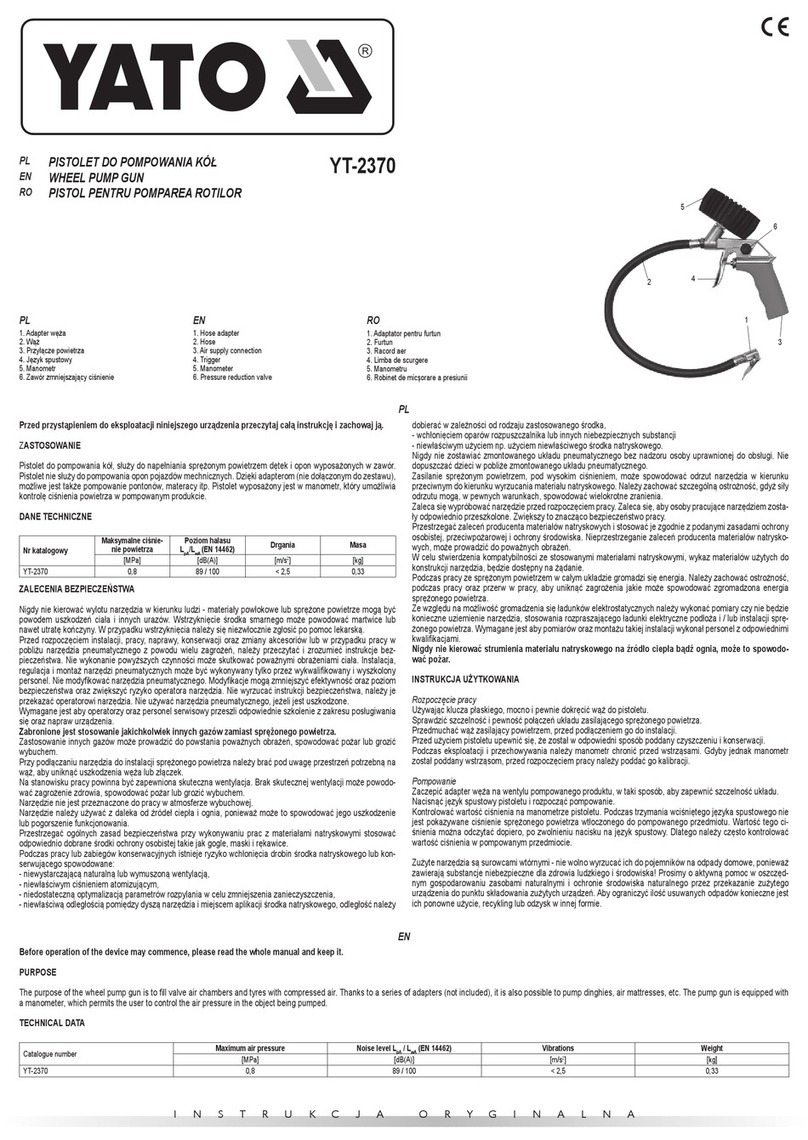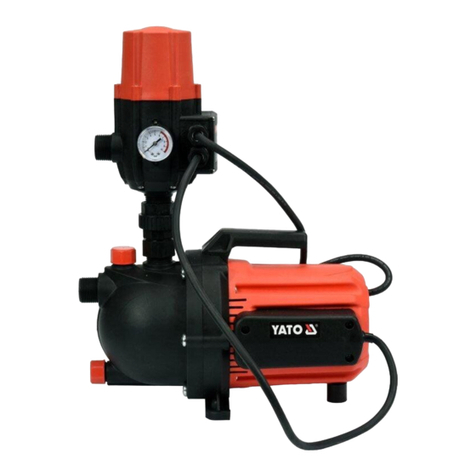
Pompka podciśnieniowa jest wielofunkcyjnym urządzeniem służącym do diagnostyki systemów w
samochodach i technice, których działanie jest oparte na ciśnieniu lub podciśnieniu. Wyposażona
jest w akcesoria umożliwiające wykorzystanie w niemal każdym silniku lub układzie. Za pomocą
pompki można przeprowadzićdiagnostykęm.in. poniższych systemów i układów.
Urządzenia skomputeryzowanego sterownia silnika
- barometryczny czujnik ciśnienia (BARO)
- system PCV
- system recyrkulacji spalin (EGR)
- grubowarstwowe czujniki ciśnienia (MAP)
Urządzenia sterowania zapłonem
- podciśnieniowe wyprzedzenie zapłonu
- zawór opóźniający: SDV, RCV
Inne systemy
- klimatyzacja
- tempomat
- zbiornik paliwa i instalacja paliwowa
- podciśnieniowy system domykania drzwi
Układ hamulcowy
- hamulce klasyczne
- hamulce ABS
- hamulce pneumatyczne
- przewody hamulcowe
- serwomechanizm hamulcowy
OGÓLNE INSTRUKCJE BEZPIECZEŃSTWA
Przed rozpoczęciem pracy przyrządem, upewnićsię, że zostałustawiony jałowy bieg, koła zostały
zablokowane, a hamulec ręczny zostałzaciągnięty.
Stosowaćochronęoczu, twarzy, dróg oddechowych oraz słuchu, tam gdzie jest wymagana.
Zachowaćszczególnąostrożność w przypadku pracy w pobliżu gorących i/ lub ruchomych ele-
mentów.
Nie zbliżaćsięz otwartym ogniem w pobliżu paliwa lub akumulatora.
Pracowaćtylko w dobrze wentylowanych pomieszczeniach. Gazy wydechowe sątrujące.Nigdy nie
rozłączaćpołączeńelektrycznych gdy włączony jest zapłon, o ile instrukcja obsługi danego układu
nie pozwala na taka operację.
Nie dotykaćżądnych styków elektrycznych.
Zabronione jest umieszczanie kabli zasilających, przedłużaczy elektrycznych i innych przewodów
pod napięciem w pobliżu instalacji elektrycznej samochodu.
Nie stosowaćpompki do pompowanie cieczy!
OBSŁUGA POMPKI
Uwaga! Każdy diagnozowany system posiada instrukcje producenta. Przed rozpoczęciem
pracy należy sięzapoznaćz tąinstrukcjąi stosowaćsiędo jej zaleceńpodczas pracy. Przed-
stawione poniżej przykłady zastosowania pompki mającharakter poglądowy, ukazujący za-
sadędziałania przyrządu.
Odpowietrzanie zacisków hamulcowych
Upewnićsię, że zbiornik wyrównawczy układu hamulcowego jest wypełniony płynem do nominalnej
objętości.
Odpowietrzanie przeprowadzićwedług poniższej kolejności:
- pompa hamulcowa, jeśli jest wyposażona w zawór odpowietrzający,
- zaciski hamulcowe w kolejności od położonego najbliżej pompy hamulcowej do położonego najdalej.
Podłączyćkrótki przewód elastyczny do przyłącza umieszczonego na spodzie pokrywy zbiornika
pompy.
Zamknąć zbiornik pompy za pomocąpokrywy.
Podłączyćdługie przewody elastyczne do przyłączy pokrywy. Koniec jednego z długich węży pod-
łączyćdo pompki, a drugiego do zaworu odpowietrzającego (kalamitki) zacisku hamulcowego. W
razie potrzeby posłużyćsięadapterem.
Nacisnąć dźwigniępompki 10 - 15 razy, aby wytworzyćpodciśnienie w zbiorniku pompy.
Odkręcićzawór odpowietrzający o 1/4 - 1/2 obrotu, tak aby zbiornik pompy wypełniłsiępłynem do
wysokości około 5 cm. Dokręcićzawór odpowietrzający.
Odłączyćprzewód pompki od zaworu odpowietrzającego, procedura odpowietrzania zacisku zo-
stała zakończona.
Przed powtórzeniem procedury odpowietrzania w kolejnym zacisku, opróżnićzbiornik pompy z
płynu hamulcowego oraz uzupełnićpoziom płynu hamulcowego, w instalacji hamulcowej, do no-
minalnego poziomu.
Diagnostyka systemu recyrkulacji spalin (EGR)
Zawór systemu EGR jest przykładem zaworu uruchamianego przez podciśnienie. W przypadku
braku podciśnienia zawór jest zamknięty i spaliny nie wydostająsięz zaworu. W przypadku dopro-
wadzenia podciśnienie do zaworu, zostaje on otwarty umożliwiając recyrkulacjęspalin.
Diagnostyka grubowarstwowych czujników ciśnienia (MAP)
Zmontowaćukład pompki i zbiornika jak w przypadku odpowietrzania zacisków hamulcowych, a
następnie podłączyćdo przyłącza podciśnieniowego czujnika.
Naciskaćdźwigniępompki, ażwskazówka pokaże -0,5 bara. Zakończyćpompowanie i obserwo-
waćwskazówkę, powinna byćnieruchoma. Jeśli wskazówka sięporusza oznacza to uszkodzenie
czujnika MAP.
W trakcie pracy czujnik MAP wysyła sygnały zwrotne do komputera sterującego. Sygnałma często-
tliwość pomiędzy 85 Hz, a 160 Hz w zależności od poziomu podciśnienia. Do pomiaru częstotliwości
konieczny jest częstościomierz, należy go podłączyćzgodnie z instrukcjączujnika i miernika.
Pompka YT-0674 jest wyposażona w przełącznik, który w zależności od położenie pozwala na wy-
tworzenie podciśnienia lub ciśnienia.
Przesunięcie przełącznika w kierunku wylotu pompki, spowoduje, że podczas pompowania będzie
wytwarzane podciśnienie. Przełącznik przesunięty w kierunku rękojeści spowoduje, że podczas
pompowania będzie wytwarzane ciśnienie.
Uwaga! Jeżeli pompka utrzymuje w układzie ciśnienie lub podciśnienie, przesunięcie przełącznika,
spowoduje powrót do stanu początkowego.
Uwaga! Manometr zostałtak fabrycznie skalibrowany, że wskazanie „0” oznacza ciśnienie 1 bara,
na poziomie morza.
A negative pressure pump is a multi-purpose device for diagnostics of vehicle and technological
system, whose operation is based upon application of positive or negative pressure. The pump is
equipped with accessories, which make it possible to use it on almost every motor or system. Using
the pump, the following systems may be diagnosed:
Computerized motor control devices
- barometric pressure sensor (BARO)
- PCV system
- Exhaust gas recirculation system (EGR)
- thick film pressure sensors (MAP)
Ignition control device
- negative pressure ignition advance
- delay valve: SDV, RCV
Other systems
- air-conditioning
- tempomat
- fuel tank and fuel installation
- negative pressure door soft close system
Braking system
- classic brakes
- ABS brakes
- pneumatic brakes
- brake conduits
- brake system servo-mechanism
GENERAL SAFETY INSTRUCTIONS
Before you proceed to operate the device, make sure the motor is idling, the wheels are blocked
and the hand brake is set.
Wear eyes, face, respiratory system and hearing protection, whenever needed.
Be particularly careful, working close to hot and/or moving elements.
Do not approach fuel or the battery with an open flame.
Work solely in properly ventilated areas. Exhaust gases are harmful.
Do not disconnect electric contacts when the ignition is on, unless the operating manual of the
system in question permits such operation.
Do not touch any electric contacts.
It is prohibited to place power supply cables, extensions and other live conductors close to the
electric installation of the vehicle.
Do not use the pump to pump liquids!
OPERATION OF THE PUMP
Attention! Each diagnoses system is accompanied with the manufacturer’s manual. Before
working with the device, it is mandatory to read thoroughly the operating manual and follow
its recommendations during work. The examples of application of the pump are for illustra-
tive purpose only, and they present the principle of operation of the device.
Deaeration of the brake callipers
Make sure, the equalization tank of the braking system is filled with brake liquid to the nominal
volume.
Deaeration should be executed in accordance with the following order:
- braking pump, if it is equipped with a purging air valve,
- brake callipers from the closest to, to the farthest from the braking pump.
Connect the short elastic hose to the connector located at the bottom of the cover of the tank of
the pump.
Close the tank of the pump with the cover.
Connect the long elastic hoses to the cover connectors. Connect the end of one of the long hoses
to the pump, and the end of the other to the purging air valve (grease fitting) of the brake calliper.
Use the adapter if necessary.
Push the pump lever 10-15 times, so as to generate negative pressure in the tank of the pump.
Open the purging air valve by a 1/4-1/2 of a turn, so that the tank of the pump is filled with liquid up
to approximately 5 cm. Tighten the purging air valve.
Disconnect the pump hose from the purging air valve; the procedure of deaeration has been con-
cluded.
Before the procedure of deaeration is repeated on another calliper, empty the tank of the pump of
brake liquid and replenish the brake liquid in the braking system to the nominal level.
Diagnostics of the exhaust gas recirculation system (EGR)
The EGR system valve is an example of a valve activated by means of negative pressure. In case
there is no negative pressure, the valve remains closed and the exhaust gases do not leave the
valve. If negative pressure is applied to the valve, it opens, which permits recirculation of exhaust
gases.
Diagnostics of thick film pressure sensors (MAP)
Assemble the pump and tank system in the same manner as in the case of deaeration of brake
callipers, and then connect it to the negative pressure connector of the sensor.
Push the pump lever until the arrow indicates -0.5 bar. Finish pumping and observe the arrow; it
should remain still. If the arrow moves, then the MAP sensor is damaged.
During work the MAP sensor sends a return signal to the control computer. The frequency of the
signal is between 85 Hz and 160 Hz, depending on the negative pressure value. A frequency meter
is necessary to measure frequency, and it must be connected in accordance with the operating
manual of the sensor and the meter.
The YT-0674 pump is equipped with a switch, which permits to generate pressure or negative pres-
sure, depending on its position.
If the switch is moved towards the outlet of the pump, negative pressure is generated during pump-
ing. If the switch is moved towards the handle, positive pressure is generated during pumping.
Attention! If the pump maintains positive or negative pressure in the system, then moving the switch
will cause a return to the initial state.
Attention! The manometer is calibrated by the manufacturer in such a manner that „0” means the
pressure of 1 bar at the sea level.



























